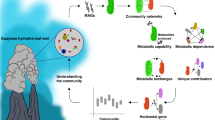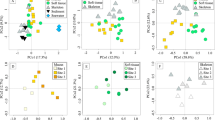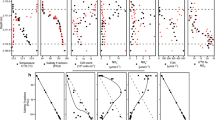Abstract
Aerobic methane oxidization in the pelagic ocean serves an important role in limiting methane release to the atmosphere, yet little is known about the identity and distribution of bacteria that mediate this process. The distribution of putative methane-oxidizing marine groups, OPU1, OPU3 and Group X, was assessed in different ocean provinces using a newly developed fingerprinting method (monooxygenase intergenic spacer analysis (MISA)) in combination with pmoA clone library analysis and quantitative PCR (qPCR). The distribution of these three distinct monooxygenase groups, previously reported from pelagic marine environments, was examined in 39 samples including active methane seeps in the Gulf of Mexico and Santa Monica Bay, submarine canyon heads along the California continental margin, an oligotrophic subtropical gyre and areas proximal to a hydrothermal vent in the North Fiji back-arc basin. OPU1 and OPU3 were widely and similarly distributed within the meso- and bathypelagic zone (110 to ∼2000 m water depth) and showed a >50-fold greater abundance near methane seeps relative to non-seep sites. In contrast, Group X was predominantly recovered from samples along the California margin, at both seep and non-seep sites. All three phylotypes were below detection in the epipelagic zone to depths of 100 m. Several additional deeply branching monooxygenase sequences were also identified in this study, indicating the presence of uncharacterized groups of microorganisms potentially involved in the cycling of methane or ammonium.
Similar content being viewed by others
Log in or create a free account to read this content
Gain free access to this article, as well as selected content from this journal and more on nature.com
or
Accession codes
References
Bodrossy L, Stralis-Pavese N, Murrell JC, Radajewski S, Weilharter A, Sessitsch A . (2003). Development and validation of a diagnostic microbial microarray for methanotrophs. Environ Microbiol 5: 566–582.
Bruland KW, Rue EL, Smith GJ . (2001). Iron and macronutrients in California coastal upwelling regimes: implications for diatom blooms. Limnol Oceanogr 46: 1661–1674.
Carini S, Bano N, LeCleir G, Joye SB . (2005). Aerobic methane oxidation and methanotroph community composition during seasonal stratification in Mono Lake, California (USA). Environ Microbiol 7: 1127–1138.
De Angelis MA, Lilley MD, Baross J . (1993). Methane oxidation in deep sea hydrothermal plumes of the endeavor segment of the Juan de Fuca Ridge. Deep Sea Res (1 Oceanogr Res Pap) 40: 1169–1186.
Delong EF . (1992). Archaea in coastal marine environments. Proc Natl Acad Sci USA 89: 5685–5689.
DeLong EF, Preston CP, Mincer T, Rich V, Hallam SJ, Frigaard N-U et al. (2006). Community genomics among stratified microbial assemblages in the ocean's interior. Science 311: 496–503.
Elsaied HE, Hayashi T, Naganuma T . (2004). Molecular analysis of deep-sea hydrothermal vent aerobic methanotrophs by targeting genes of 16S rRNA and particulate methane monooxygenase. Mar Biotechnol (NY) 6: 503–509.
Etiope G, Lassey KR, Klusman RW, Boschi E . (2008). Reappraisal of the fossil methane budget and emission from geologic sources. Geophys Res Lett 35: L09307.
Fisher MM, Triplett EW . (1999). Automated approach for ribosomal intergenic spacer analysis of microbial diversity and its application to freshwater bacterial communities. Appl Environ Microbiol 65: 4630–4636.
Goffredi SK, Wilpiszeski R, Lee R, Orphan VJ . (2008). Temporal evolution of methane cycling and phylogenetic diversity of archaea in sediments from a deep-sea whalefall in Monterey Canyon, California. ISME J 2: 204–220.
Hayashi T, Obata H, Gamo T, Sano Y, Naganuma T . (2007). Distribution and phylogenetic characteristics of the genes encoding enzymes relevant to methane oxidation in oxygen minimum zones of the eastern Pacific Ocean. Res J Environ Sci 1: 275–284.
Holmes AJ, Costello A, Lidstrom ME, Murrell JC . (1995). Evidence that particulate methane monooxygenase and ammonia monooxygenase may be evolutionarily related. FEMS Microbiol Lett 132: 203–208.
Holmes ME, Sansone FJ, Rust TM, Popp BN . (2000). Methane production, consumption, and air-sea exchange in the open ocean: an evaluation based on carbon isotopic ratios. Global Biogeochem Cycles 14: 1–10.
Horz HP, Rich V, Avrahami S, Bohannan BJM . (2005). Methane-oxidizing bacteria in a California upland grassland soil: diversity and response to simulated global change. Appl Environ Microbiol 71: 2642–2652.
Jensen S, Neufeld JD, Birkeland NK, Hovland M, Murrell JC . (2008). Insight into the microbial community structure of a Norwegian deep-water coral reef environment. Deep-Sea Res (I Oceanogr Res Pap) 55: 1554–1563.
Jones RD . (1991). Carbon-monoxide and methane distribution and consumption in the photic zone of the Sargasso Sea. Deep-Sea Res (Pt A Oceanogr Res Pap) 38: 625–635.
Joye SB, Boetius A, Orcutt BN, Montoya JP, Schulz HN, Erickson M et al. (2004). The anaerobic oxidation of methane and sulfate reduction in sediments from Gulf of Mexico cold seeps. Chem Geol 205: 219–238.
Mau S, Valentine DL, Clark JF, Reed J, Camilli R, Washburn L . (2007). Dissolved methane distributions and air-sea flux in the plume of a massive seep field, Coal Oil Point, California. Geophys Res Lett 34: L22603.
Normark WR, Hein JR . (2003). Methane hydrate recovered from a mud volcano in Santa Monica Basin, offshore southern California. Eos Trans AGU 84(46), Fall Meet Suppl, Abstract OS51B-0855.
Norton JM, Alzerreca JJ, Suwa Y, Klotz MG . (2002). Diversity of ammonia monooxygenase operon in autotrophic ammonia-oxidizing bacteria. Arch Microbiol 177: 139–149.
Podgorsek L, Petri R, Imhoff JF . (2004). Cultured and genetic diversity, and activities of sulfur-oxidizing bacteria in low-temperature hydrothermal fluids of the North Fiji Basin. Mar Ecol-Prog Ser 266: 65–76.
Qiu QF, Noll M, Abraham WR, Lu YH, Conrad R . (2008). Applying stable isotope probing of phospholipid fatty acids and rRNA in a Chinese rice field to study activity and composition of the methanotrophic bacterial communities in situ. ISME J 2: 602–614.
Seifert R, Delling N, Richnow HH, Kempe S, Hefter J, Michaelis W . (1999). Ethylene and methane in the upper water column of the subtropical Atlantic. Biogeochemistry 44: 73–91.
Solomon EA, Kastner M, Jannasch H, Robertson G, Weinstein Y . (2008). Dynamic fluid flow and chemical fluxes associated with a seafloor gas hydrate deposit on the northern Gulf of Mexico slope. Earth Planet Sci Lett 270: 95–105.
Solomon EA, Kastner M, MacDonald IR, Leifer I . (2009). Considerable methane fluxes to the atmosphere from hydrocarbon seeps in the Gulf of Mexico. Nat Geosci 2: 561–565.
Steinberg DK, Carlson CA, Bates NR, Johnson RJ, Michaels AF, Knap AH . (2001). Overview of the US JGOFS Bermuda Atlantic time-series study (BATS): a decade-scale look at ocean biology and biogeochemistry. Deep-Sea Res (Pt Ii-Top Stud Oceanogr) 48: 1405–1447.
Tamura K, Dudley J, Nei M, Kumar S . (2007). MEGA4: molecular evolutionary genetics analysis (MEGA) software version 4.0. Mol Biol Evol 24: 1596–1599.
Tavormina PL, Ussler W, Orphan VJ . (2008). Planktonic and sediment-associated aerobic methanotrophs in two seep systems along the North American margin. Appl Environ Microbiol 74: 3985–3995.
Ussler W, Paull CK, Normark WR . (2006). Methane gas emanation from an active carbonate mound in Santa Monica Basin, offshore southern California. Geophys Res Abstr 8, Abstract 05223.
Valentine DL, Blanton DC, Reeburgh WS, Kastner M . (2001). Water column methane oxidation adjacent to an area of active hydrate dissociation, Eel River Basin. Geochim Cosmochim Acta 65: 2633–2640.
Ward BB, Kilpatrick KA, Novelli PC, Scranton MI . (1987). Methane oxidation and methane fluxes in the ocean surface-layer and deep anoxic waters. Nature 327: 226–229.
Wasmund K, Kurtboke DI, Burns KA, Bourne DG . (2009). Microbial diversity in sediments associated with a shallow methane seep in the tropical Timor Sea of Australia reveals a novel aerobic methanotroph diversity. FEMS Microbiol Ecol 68: 142–151.
Acknowledgements
We thank Mary Lidstrom, Dan Arp and Martin Klotz for reference strains, Steve Giovannoni's group for BATS DNA, Bob Vrijenhoek for the Fiji/Lau expedition and Shana Goffredi, Olivia Mason, and 3 anonymous reviewers for assistance, critical comments, and improving the quality of this study. Support was provided by NASA (NNG06GB34G to VJO), NSF (MCB-0348492 to VJO and OCE-0085549 to SBJ), the Gordon and Betty Moore Foundation (to VJO) and the David and Lucile Packard Foundation (to WU).
Author information
Authors and Affiliations
Corresponding author
Additional information
Supplementary Information accompanies the paper on The ISME Journal website
Rights and permissions
About this article
Cite this article
Tavormina, P., Ussler, W., Joye, S. et al. Distributions of putative aerobic methanotrophs in diverse pelagic marine environments. ISME J 4, 700–710 (2010). https://doi.org/10.1038/ismej.2009.155
Received:
Revised:
Accepted:
Published:
Issue date:
DOI: https://doi.org/10.1038/ismej.2009.155
Keywords
This article is cited by
-
In situ development of a methanotrophic microbiome in deep-sea sediments
The ISME Journal (2019)
-
Methylococcaceae are the dominant active aerobic methanotrophs in a Chinese tidal marsh
Environmental Science and Pollution Research (2019)
-
Origin and fate of methane in the Eastern Tropical North Pacific oxygen minimum zone
The ISME Journal (2017)
-
Mixotrophy drives niche expansion of verrucomicrobial methanotrophs
The ISME Journal (2017)
-
Anaerobic Methane-Oxidizing Microbial Community in a Coastal Marine Sediment: Anaerobic Methanotrophy Dominated by ANME-3
Microbial Ecology (2017)



